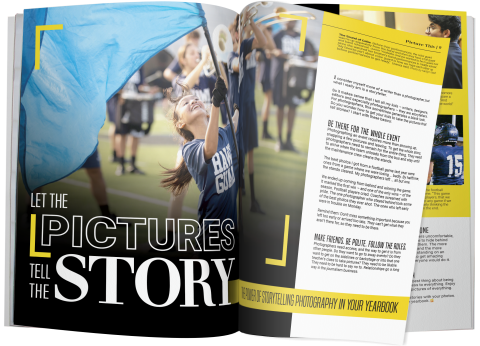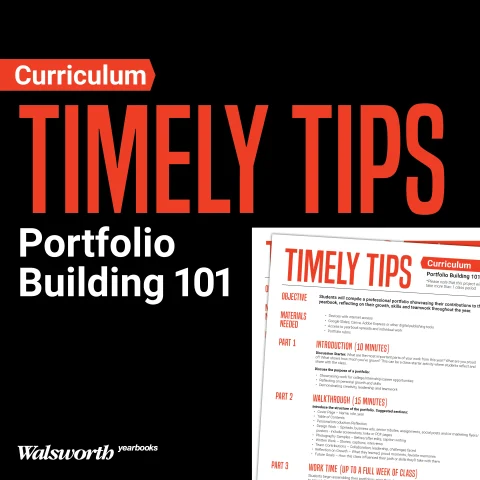I consider myself more of a writer than a photographer, but what I really am is a storyteller.
So it makes sense that I tell all my kids – writers, designers, editors and especially photographers – they are storytellers. For photographers, this sometimes generates a blank look. Do you wonder how to get your kids to take the pictures that tell stories? I start with these basics:
Be There For the Whole Event
Photographing an event requires more than showing up, snapping a few pictures and leaving. To get the whole story, photographers need to remain for the entire thing. They need to arrive when the team unloads from the bus and stay until the maintenance crew cleans the stands.
The best photos I got from a football game last year were ones from a game where we were losing … badly. By halftime, the stands cleared. My photographers left … all but one.
We ended up coming from behind and winning the game. It marked the first win – and one of the only wins – of the season. Football players cried. Coaches screamed with pride. The one photographer who stayed behind took some of the best photos they ever shot. The ones who left early were in trouble on Monday.
Remind them: Don’t miss something important because you left too early or arrived too late. They can’t get what they aren’t there for, so they need to be there.
Make Friends. Be Polite. Follow the Rules.
Photographers need access, and the way to get it is from other people. Do they want to go to away events? Do they want to get on the sidelines or backstage or into that one teacher’s class to take pictures? They need to be likable. They need to be hard to say no to. Relationships go a long way in the journalism business.
Photograph Everything and Everyone
There is so much more to an event than just the game. At the average high school football game, plan to shoot the game, sidelines, band, trainers, cheerleaders, fans and dance team. And that’s just the starting list.
Divide and Conquer
If multiple photographers attend the same event, they should not all shoot the same thing from the same location. Assign one person the game, another to the sidelines, another to the crowd. Switch positions every so often. Just have them communicate with each other to avoid missing something.
Don’t stand in the same place. I often have photographers go to an event together and stand together the whole time. When this happens, you end up with duplicate photos. They have to break away from their security blanket best friend.
Get the Face
I remind my kids as they go to an event to “get the face.” What is a story without emotions? How are you going to show the emotions without faces?
Especially with sports, it’s hard to get faces. I get it. The players line up with their backs to the photographer. Helmets obstruct facial expressions, but nobody wants to see pictures of the back of someone’s head.
To “get the face,” they might need to:
- Move their bodies. They can’t stand in the same place the entire time and expect different shots. To get the front of the players lined up with their backs to the stands, they must go around them and stand to the side or front of them.
- Teach them to zoom with their feet. If they need to zoom in closer to something, they need to move closer.
- Don’t shoot the game from the stands. The only reason a photographer should be in the stands is to get crowd shots, the band or dance team. Don’t be afraid to go to the other side. Good pictures don’t just happen from the home side. Move around!
- Try another angle. One of the easiest ways to tell a story with a photo is to change the angle. If they’ve never laid on the ground or stood on something to take a picture, it’s time to try.
One of our cross country runners placed 7th at state. Really good, right? Except that meant he didn’t medal at state. Devastated by what he considered a loss, he sat on the ground crying. The photographer took an image of him from above. The photo was poignant. The angle made it more effective.
Think Like a Journalist
Photographers need to ask questions, embrace curiosity and find answers with their camera. Start looking at the event from all perspectives—how do they do that? Why do they do that?
Did you know those feathers that go in the hats the band wears are stored separately in little tubes until right before the band takes the field? Did you know there is a crew of parents who wait on the sidelines to hand each band member an iced down bottle of water as soon as the half-time show ends? Have you ever watched students load their instruments, Tetris-like into a trailer? What about the dance team putting on their makeup before a game?
For theater, don’t just take pictures of the play. Go backstage and get shots of the crew. Go to the light booth. For academics, photograph the teacher setting up the lab before school. What do teachers do immediately after school? Do they cut and run to the parking lot? Do they hang out in the hallway chatting like teenagers?
Use the Camera You Have
Picture this: Your photographer sits in chemistry as their teacher dips their hand in soap bubbles and then lights their hand on fire. They proceed to tell the class everyone is going to light their hand on fire. I hope they think, “I’ve got to get pictures of this for the yearbook!” Train them to think that!
If they don’t have time to leave class, run to the journalism room and set up a camera, they need to use their phone. Take class time for them to familiarize themselves with the settings on their phone cameras now so when opportunities arise, they can step up. Treat those moments like any other. Use framing, leading lines and angles.
Document More Than Just Wins
Don’t shy away from shooting the hard stuff. Teams lose. That’s part of the story. You need to document it all. Even if it makes you uncomfortable.
Get Out of Your Comfort Zone
My advice may make your photographers uncomfortable, and I’m sorry. Some photographers like to hide behind their cameras, hoping no one notices them. The more they do it, the less awkward they feel and the more people around them understand that standing on an ice chest is just part of what you do to get amazing photos. Remember, if it was easy, everyone would do it.
Don’t Forget to Have Fun
One of my photographers said the best thing about being in yearbook is that it gives you access to everything. Enjoy that access. Go everywhere. Take pictures of everything.
Don’t just take pictures, tell great stories with your photos. They are the heart and soul of the yearbook.
Want to read more timely topics related to yearbook? Take a look at the fall Idea File magazine online to see different stories focused on how to make your yearbook the best it can be.




